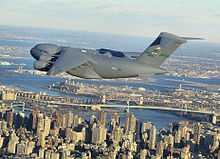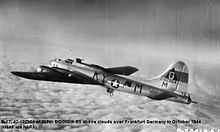305th Operations Group
| 305th Operations Group | |
|---|---|
 Emblem of the World War II 305th Bombardment Group | |
| Active | 1942–1946; 1947–1948; 1950–1952; 1991–1993; 1994–present |
| Country | United States |
| Branch | United States Air Force |
| Garrison/HQ | Joint Base McGuire-Dix-Lakehurst |


The 305th Operations Group (305th OG) is a United States Air Force unit assigned to the 305th Air Mobility Wing. It is stationed at Joint Base McGuire-Dix-Lakehurst, New Jersey.
During World War II, the group's predecessor unit, the 305th Bombardment Group was one of the first VIII Bomber Command B-17 Flying Fortress units in England and was one of the most decorated USAAF heavy bombardment groups in the European Theater. 1st Lt William R. Lawley, Jr. and 1st Lt Edward S. Michael, pilots in the 364th Bomb Squadron, each received the Medal of Honor.
While commanded by Colonel Curtis LeMay the Group pioneered many bomber flying formations and bombing procedures that became the standard operating procedures in the Eighth Air Force. It suffered the heaviest loss of 14 October 1943 Schweinfurt–Regensburg mission, and for this reason was given the Nazi flag found flying in the city when it was captured by the US troops in April 1945.
Overview
The mission of the 305th Operations Group is to deploy worldwide from Air Mobility Command's Eastern Gateway, Joint Base McGuire-Dix-Lakehurst (JB MDL), to perform aerial refueling and airlift, in support of tactical, strategic, reconnaissance, transport, and bombardment forces in high-threat and chemical warfare environments.
The group flies the C-17 Globemaster III and KC-10 Extender in support of worldwide operations.
Components
The group comprises the following squadrons:
- 2d Air Refueling Squadron (KC-10)
- The 2nd ARS provides the United States with the Global Reach necessary to support our national security objectives, while placing an increased emphasis on squadron members' families-the unsung heroes of the unit's successful operations.
- 6th Airlift Squadron (C-17)
- The 6th Airlift Squadron is the oldest airlift squadron in the Air Force, having served with distinction since 1 October 1933.
- 32d Air Refueling Squadron (KC-10)
- The 32nd ARS can generate, mobilize and deploy 16 KC-10 aircraft with more than 180 aircrew, maintenance and support people to fulfill a wide variety of worldwide mobility taskings.
- 305th Operations Support Squadron
- The mission of the 305th OSS is to provide information, support, and equipment to allow aircrews to accomplish their global mobility mission.
History
- For additional history and lineage, see 305th Air Mobility Wing
World War II


Activated 1 March 1942 at Salt Lake City AB, Utah. They trained there until 2 March 1943. Then moved to Geiger Field, Washington on 11 June 1942 Intensive training at Muroc Lake AB, California from the 29t to 20 June August 1942. The ground unit went by train to at Fort Dix, New Jersey. The ground unit sailed on the Queen Mary on 5 September 1942, and disembarked from Greenock on 12 September 1942. the Aircraft assembled at Syracuse, New York and spent six weeks in advance flight training. They received new B-17F bombers, and left for the United Kingdom in October 1942 via the presque Isle, and Gander to Prestwick.
Deployed to England in September 1942 and formed at RAF Grafton Underwood as part of VIII Bomber Command 40th Bombardment Wing. Was assigned group tail code "Triangle-G". At Grafton Underwood, the group began combat on 17 November 1942 and attacked such targets as submarine pens, docks, harbours, shipyards, motor works, and marshalling yards in France, Germany, and the Low Countries. During December 1942, the group was transferred to RAF Chelveston.
On 27 January 1943, the group participated in the Eighth Air Force's first raid on Germany. During the winter of 1942/43, the 305th was commanded by Colonel Curtis LeMay and pioneered many of the techniques of daylight bombing used by the USAAF over Nazi-controlled Europe. These fundamental procedures and techniques were later adapted to the B-29 Super Fortresses which fought the war to its conclusion in the Pacific.
The 305th BG bombed the navy yards at Wilhelmshaven on 27 January 1943 when heavy bombers of Eighth AF made their first penetration into Germany. Through mid-1943, the group attacked strategic targets as submarine pens, docks, harbors, shipyards, motor works, and marshaling yards in France, Germany, and the Low Countries.
The 305th BG received the Distinguished Unit Citation for a mission on April 1943 when an industrial target in Paris was bombed with precision in spite of pressing enemy fighter attacks and heavy flak.
During the second half of 1943, the unit began deeper penetration into enemy territory to strike heavy industry. Significant objectives included aluminum, magnesium, and nitrate works in Norway, industries in Berlin, oil plants at Merseburg, aircraft factories at Anklam, shipping at Gdynia, and ball-bearing works at Schweinfurt.
A second Distinguished Unit Citation was awarded to the 305th for withstanding severe opposition to bomb aircraft factories in central Germany on 11 January 1944. The unit participated in the intensive campaign of heavy bombers against the German aircraft industry during Big Week, 20–25 February 1944.
In addition to bombardment of strategic targets, the 305th BG often flew tactical interdictory missions and supported infantry units. Prior to the Normandy invasion in June 1944, it helped to neutralize enemy installations such as V-weapon sites, airfields, and repair shops. On D-Day, 6 June, the unit bombed enemy strongholds near the battle area. During the Battle of Normandy the 305th attacked enemy positions in advance of ground forces at Saint-Lô in July 1944 and struck antiaircraft batteries to cover the airborne invasion of Holland in September.
After V-E Day, the 305th moved to St Trond Air Base, Belgium in July 1945 where it conducted photo-mapping flights which was called Project: Casey Jones over Europe and North Africa. On 15 December 1945 moved to Lechfeld, Germany which they had bombed on 18 March 1944. The 364th Bomb Squadron was inactivated on 1 July 1946. The 423 Bomb Squadron of the 306th Bomb Group was attached to the Group after this date but by the end of October 1946 the Group ceased all operations. Officially the unit was inactivated on 25 December 1946. On the Continent it was assigned to Ninth Air Force and inactivated on 15 November 1945.
Cold War
Not operational from 16 October-25 December 1946. During two periods of activation, between July 1947 and September 1948 and between January 1951 and June 1952, the group was manned only from 2 January-9 February 1951 when the Air Force reorganized its wings into the tri-deputate system.
Modern era
On 1 September 1991, the 305th Operations Group activated under the "Objective Wing" concept adapted by the Air Force as the lines between tactical and strategic forces blurred. The flying components of the 305th Air Refueling Wing were reassigned to the newly established group. Upon activation, the 305 OG was bestowed the history, lineage and honors of the 305th Bombardment Group from the wing.
The 1993 Base Realignment and Closure (BRAC) directed realignment of Grissom AFB to the Air Force Reserve and the 305th OG phased out operations there in 1994. The KC-135R equipped 70th and 305th ARS were inactivated. In addition, the EC-135G/L radio relay aircraft as part of the PACCS system were also retired.
The 305th was moved without personnel or equipment to McGuire AFB, New Jersey, replacing the 438th Operations Group on 1 October 1994. At McGuire, the group controls three squadrons of Boeing C-17A Globemaster III transports and Douglas KC-10A Extender air refueling aircraft.
Lineage
- Established as 305 Bombardment Group (Heavy) on 28 January 1942
- Activated on 1 March 1942
- Redesignated 305 Bombardment Group, Heavy, on 20 August 1943
- Inactivated on 25 December 1946
- Redesignated 305 Bombardment Group, Very Heavy, on 11 June 1947
- Activated on 1 July 1947
- Inactivated on 6 September 1948
- Redesignated 305 Bombardment Group, Medium, on 20 December 1950
- Activated on 2 January 1951
- Inactivated on 16 June 1952
- Redesignated 305 Operations Group on 29 August 1991
- Activated on 1 September 1991
- Inactivated on 15 October 1993
- Activated on 1 October 1994.
Assignments
|
|
Components
- 2d Air Refueling Squadron1 July 1995–present
- 6th Airlift Squadron: 1 October 1994–present
- 13th Airlift Squadron: 1 October 1994 – 31 March 2000
- 18th Airlift Squadron: 1 October 1994 – 1 July 1995
- 32d Air Refueling Squadron: 1 July 1995–present
- 33d Reconnaissance (later, 422d Bombardment) Squadron: 1 March 1942 – 25 December 1946
- 46th Air Refueling Squadron: 1 June 1992 – 8 October 1993
- 70th Air Refueling Squadron: 1 September 1991 – 1 April 1993
- 305th Air Refueling Squadron: 2 July 1951 – 16 June 1952 (detached entire period); 1 September 1991 – 20 August 1993
- 364th Bombardment Squadron (WF): 1 March 1942 – 29 June 1946; 1 July 1947 – 6 September 1948; 2 January 1951 – 16 June 1952 (detached 10 February 1951 – 16 June 1952)
- 365th Bombardment Squadron (XK): 1 March 1942 – 31 October 1946; 1 July 1947 – 6 September 1948; 2 January 1951 – 16 June 1952 (detached 10 February 1951 – 16 June 1952)
- 366th Bombardment Squadron (KY): 1 March 1942 – 25 December 1946; 1 July 1947 – 6 September 1948; 2 January 1951 – 16 June 1952 (detached 10 February 1951 – 16 June 1952)
- 423d Bombardment Squadron (JJ): attached 16 July-25 December 1946
- 905th Air Refueling Squadron: 1 June 1992 – 1 July 1993
- 920th Air Refueling Squadron: 1 June-30 September 1992.
Stations
|
|
Aircraft assigned
|
|
References
![]() This article incorporates public domain material from websites or documents of the Air Force Historical Research Agency.
This article incorporates public domain material from websites or documents of the Air Force Historical Research Agency.
- Joint Base McGuire-Dix-Lakehurst (Official Web site)
- Air Mobility Command (Official Web site)
- Maurer, Maurer (1983). Air Force Combat Units Of World War II. Maxwell AFB, Alabama: Office of Air Force History. ISBN 0-89201-092-4.
- Freeman, Roger A. (1978) Airfields of the Eighth: Then and Now. After the Battle ISBN 0-900913-09-6
- Freeman, Roger A. (1991) The Mighty Eighth The Colour Record. Cassell & Co. ISBN 0-304-35708-1
- Rogers, Brian (2005). United States Air Force Unit Designations Since 1978. Hinkley, England: Midland Publications. ISBN 1-85780-197-0.
- USAAS-USAAC-USAAF-USAF Aircraft Serial Numbers—1908 to present
External links
| Wikimedia Commons has media related to 305th Operations Group . |
| ||||||||||||||||||||||||||||||||||||
| |||||||||||||||||||||||||||||||||||||||||||||||||||||
| |||||||||||||||||||||||||||||||||


